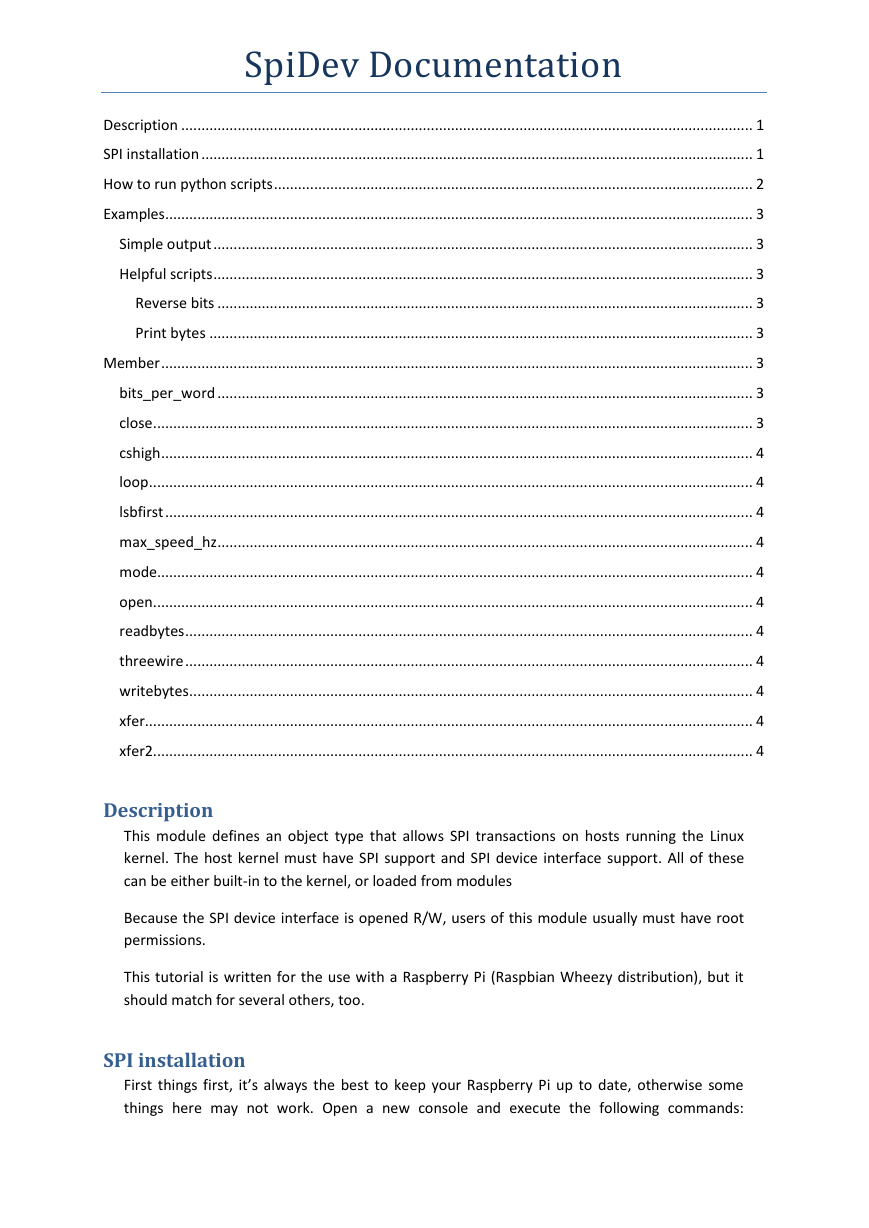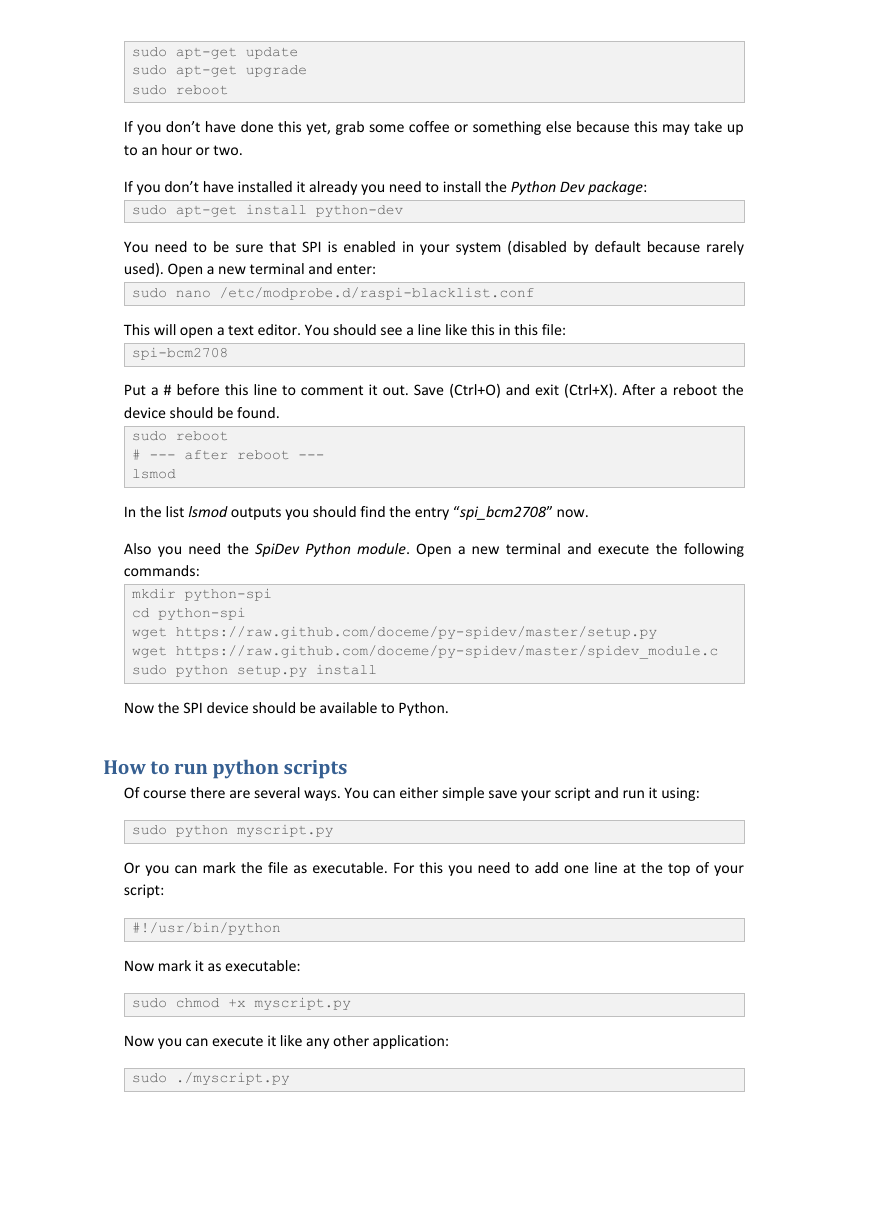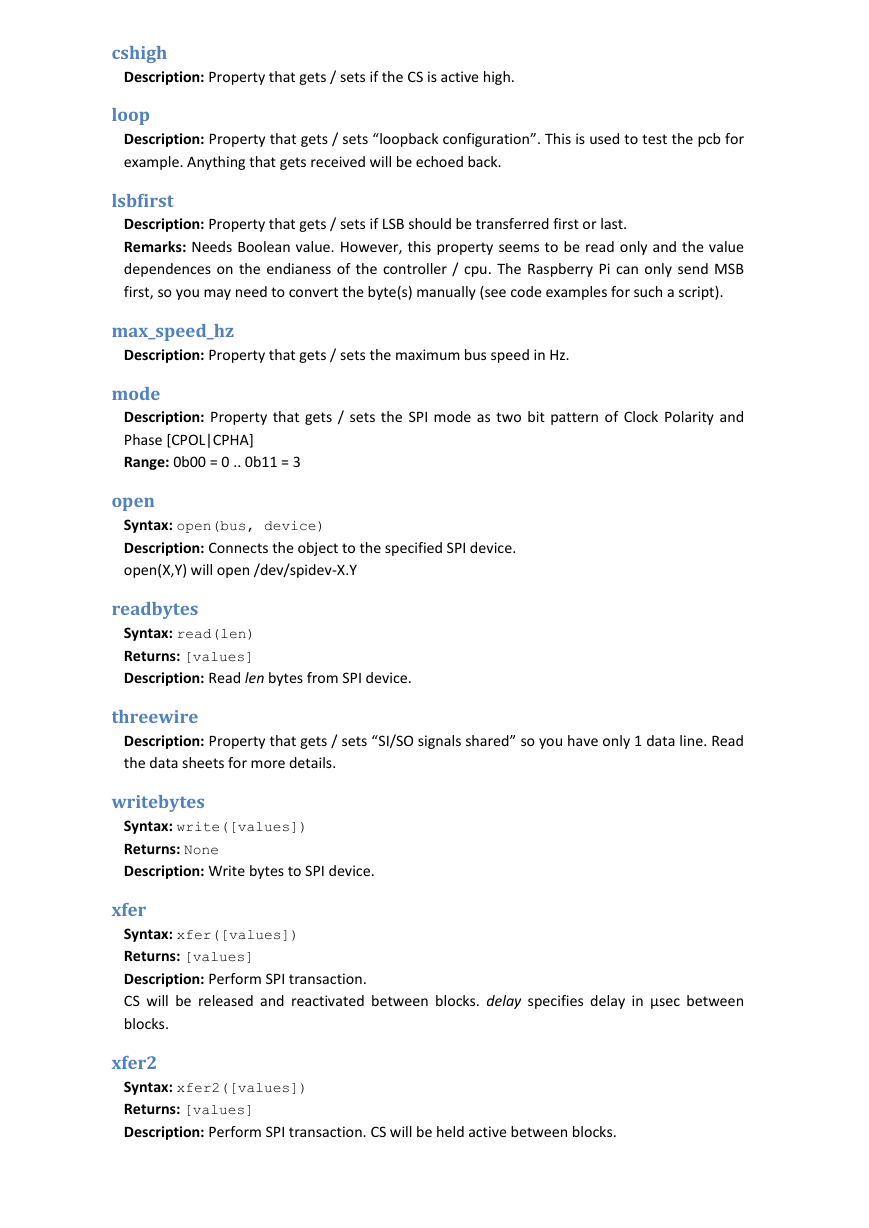SpiDev Documentation
Description .............................................................................................................................................. 1
SPI installation ......................................................................................................................................... 1
How to run python scripts ....................................................................................................................... 2
Examples .................................................................................................................................................. 3
Simple output ...................................................................................................................................... 3
Helpful scripts ...................................................................................................................................... 3
Reverse bits ..................................................................................................................................... 3
Print bytes ....................................................................................................................................... 3
Member ................................................................................................................................................... 3
bits_per_word ..................................................................................................................................... 3
close ..................................................................................................................................................... 3
cshigh ................................................................................................................................................... 4
loop ...................................................................................................................................................... 4
lsbfirst .................................................................................................................................................. 4
max_speed_hz ..................................................................................................................................... 4
mode.................................................................................................................................................... 4
open ..................................................................................................................................................... 4
readbytes ............................................................................................................................................. 4
threewire ............................................................................................................................................. 4
writebytes ............................................................................................................................................ 4
xfer ....................................................................................................................................................... 4
xfer2..................................................................................................................................................... 4
Description
This module defines an object type that allows SPI transactions on hosts running the Linux
kernel. The host kernel must have SPI support and SPI device interface support. All of these
can be either built-in to the kernel, or loaded from modules
Because the SPI device interface is opened R/W, users of this module usually must have root
permissions.
This tutorial is written for the use with a Raspberry Pi (Raspbian Wheezy distribution), but it
should match for several others, too.
SPI installation
First things first, it’s always the best to keep your Raspberry Pi up to date, otherwise some
things here may not work. Open a new console and execute the following commands:
�
sudo apt-get update
sudo apt-get upgrade
sudo reboot
If you don’t have done this yet, grab some coffee or something else because this may take up
to an hour or two.
If you don’t have installed it already you need to install the Python Dev package:
sudo apt-get install python-dev
You need to be sure that SPI is enabled in your system (disabled by default because rarely
used). Open a new terminal and enter:
sudo nano /etc/modprobe.d/raspi-blacklist.conf
This will open a text editor. You should see a line like this in this file:
spi-bcm2708
Put a # before this line to comment it out. Save (Ctrl+O) and exit (Ctrl+X). After a reboot the
device should be found.
sudo reboot
# --- after reboot ---
lsmod
In the list lsmod outputs you should find the entry “spi_bcm2708” now.
Also you need the SpiDev Python module. Open a new terminal and execute the following
commands:
mkdir python-spi
cd python-spi
wget https://raw.github.com/doceme/py-spidev/master/setup.py
wget https://raw.github.com/doceme/py-spidev/master/spidev_module.c
sudo python setup.py install
Now the SPI device should be available to Python.
How to run python scripts
Of course there are several ways. You can either simple save your script and run it using:
sudo python myscript.py
Or you can mark the file as executable. For this you need to add one line at the top of your
script:
#!/usr/bin/python
Now mark it as executable:
sudo chmod +x myscript.py
Now you can execute it like any other application:
sudo ./myscript.py
�
Examples
Simple output
This example will open SPI and writes a byte (0xAA) to it each 0.1 second until you cancel it
with Ctrl+C.
import spidev
import time
spi = spidev.SpiDev()
# create spi object
spi.open(0, 1)
# open spi port 0, device (CS) 1
try:
while True:
resp = spi.xfer2([0xAA])
# transfer one byte
time.sleep(0.1)
# sleep for 0.1 seconds
#end while
except KeyboardInterrupt:
# Ctrl+C pressed, so…
spi.close()
#end try
Helpful scripts
# … close the port before exit
Reverse bits
This script will reverse the bit ordering in one byte (if you are not able to change LSB / MSB
first to your needs.
def ReverseBits(byte):
byte = ((byte & 0xF0) >> 4) | ((byte & 0x0F) << 4)
byte = ((byte & 0xCC) >> 2) | ((byte & 0x33) << 2)
byte = ((byte & 0xAA) >> 1) | ((byte & 0x55) << 1)
return byte
#end def
Print bytes
This script will print out a byte array in a human readable format (hexadecimal). This is often
useful during debugging.
def BytesToHex(Bytes):
return ''.join(["0x%02X " % x for x in Bytes]).strip()
#end def
Member
bits_per_word
Description: Property that gets / sets the bits per word.
Range: 8 .. 16
close
Syntax: close()
Returns: None
Description: Disconnects the object from the interface.
�
cshigh
Description: Property that gets / sets if the CS is active high.
loop
Description: Property that gets / sets “loopback configuration”. This is used to test the pcb for
example. Anything that gets received will be echoed back.
lsbfirst
Description: Property that gets / sets if LSB should be transferred first or last.
Remarks: Needs Boolean value. However, this property seems to be read only and the value
dependences on the endianess of the controller / cpu. The Raspberry Pi can only send MSB
first, so you may need to convert the byte(s) manually (see code examples for such a script).
max_speed_hz
Description: Property that gets / sets the maximum bus speed in Hz.
mode
Description: Property that gets / sets the SPI mode as two bit pattern of Clock Polarity and
Phase [CPOL|CPHA]
Range: 0b00 = 0 .. 0b11 = 3
open
Syntax: open(bus, device)
Description: Connects the object to the specified SPI device.
open(X,Y) will open /dev/spidev-X.Y
readbytes
Syntax: read(len)
Returns: [values]
Description: Read len bytes from SPI device.
threewire
Description: Property that gets / sets “SI/SO signals shared” so you have only 1 data line. Read
the data sheets for more details.
writebytes
Syntax: write([values])
Returns: None
Description: Write bytes to SPI device.
xfer
Syntax: xfer([values])
Returns: [values]
Description: Perform SPI transaction.
CS will be released and reactivated between blocks. delay specifies delay in µsec between
blocks.
xfer2
Syntax: xfer2([values])
Returns: [values]
Description: Perform SPI transaction. CS will be held active between blocks.
�








 2023年江西萍乡中考道德与法治真题及答案.doc
2023年江西萍乡中考道德与法治真题及答案.doc 2012年重庆南川中考生物真题及答案.doc
2012年重庆南川中考生物真题及答案.doc 2013年江西师范大学地理学综合及文艺理论基础考研真题.doc
2013年江西师范大学地理学综合及文艺理论基础考研真题.doc 2020年四川甘孜小升初语文真题及答案I卷.doc
2020年四川甘孜小升初语文真题及答案I卷.doc 2020年注册岩土工程师专业基础考试真题及答案.doc
2020年注册岩土工程师专业基础考试真题及答案.doc 2023-2024学年福建省厦门市九年级上学期数学月考试题及答案.doc
2023-2024学年福建省厦门市九年级上学期数学月考试题及答案.doc 2021-2022学年辽宁省沈阳市大东区九年级上学期语文期末试题及答案.doc
2021-2022学年辽宁省沈阳市大东区九年级上学期语文期末试题及答案.doc 2022-2023学年北京东城区初三第一学期物理期末试卷及答案.doc
2022-2023学年北京东城区初三第一学期物理期末试卷及答案.doc 2018上半年江西教师资格初中地理学科知识与教学能力真题及答案.doc
2018上半年江西教师资格初中地理学科知识与教学能力真题及答案.doc 2012年河北国家公务员申论考试真题及答案-省级.doc
2012年河北国家公务员申论考试真题及答案-省级.doc 2020-2021学年江苏省扬州市江都区邵樊片九年级上学期数学第一次质量检测试题及答案.doc
2020-2021学年江苏省扬州市江都区邵樊片九年级上学期数学第一次质量检测试题及答案.doc 2022下半年黑龙江教师资格证中学综合素质真题及答案.doc
2022下半年黑龙江教师资格证中学综合素质真题及答案.doc